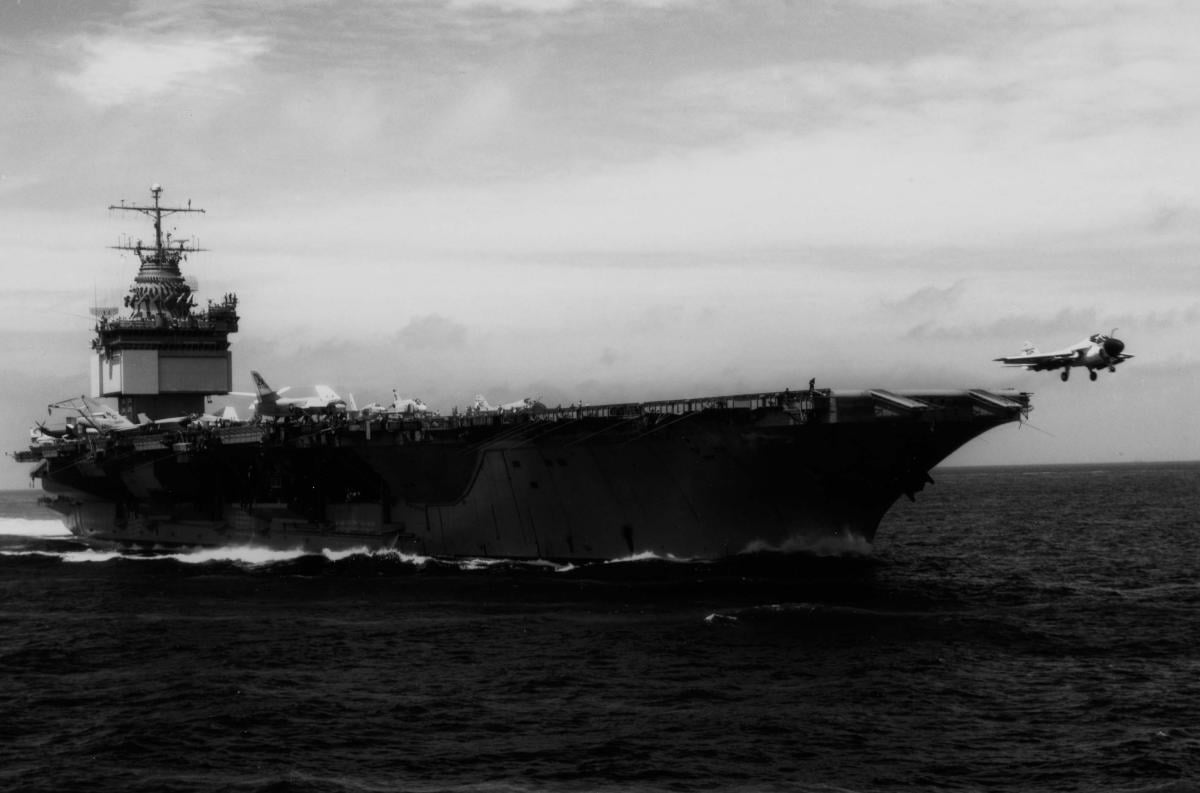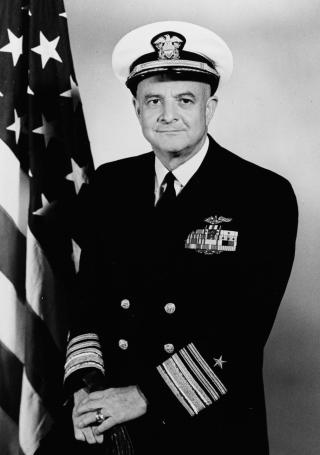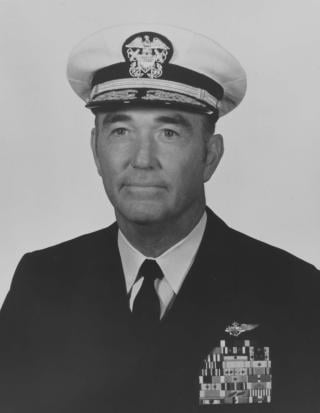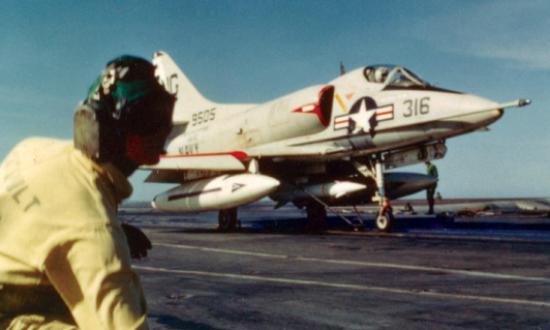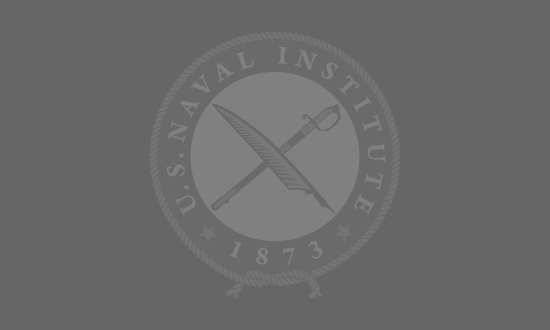First of Three Parts
Early after midnight on 21 November 1970, the U.S. Navy in the Gulf of Tonkin executed what should be lauded as the greatest special operations deception in modern warfare by assisting the Army and the Air Force in their attempt to rescue American prisoners of war from Son Tay in North Vietnam.
Perhaps the main reason why this unique operation is not regarded as such by our military historians is because its principal creator, Vice Admiral Frederick A. Bardshar, Commander of Task Force 77 (TF-77), ordered his subordinates to destroy all copies of the plans and prohibited publicity about the operation’s execution. Now, more than 50 years later, it is recognized by historians as a tremendous tactical success, and the Navy deserves due credit for its critical role in it. The raid did not rescue anyone; however, it saved the lives of many suffering prisoners and resulted in more humane treatment for all who remained captive in North Vietnam.
Naval diversion for the raid was first suggested only as a postscript when the proponents of the POW rescue plan briefed the Joint Chiefs of Staff (JCS) on 10 July 1970. Because the Navy was not included in the air and ground operation plan named “Polar Circle,” the JCS suggested that available carriers in the Gulf of Tonkin could participate by launching some aircraft to divert the attention of North Vietnamese air defenses from the objective area west of Hanoi.
This briefing took place at a time of major realignment in the top leadership of the U. S. Navy. Its Chief of Naval Operations (CNO), Admiral Thomas A. Moorer, was designated to become the new JCS Chairman. His successor as CNO was Admiral Elmo R. Zumwalt. This was his first JCS meeting. Perhaps because of his newness as the CNO, he deferred the level of naval participation to the Commander of TF-77 in the Gulf of Tonkin, Vice Admiral Frederick A. Bardshar.1
The JCS endorsed the plan with enthusiasm and authorized formation of a special task force to execute it. Brigadier General LeRoy J. Manor, Commander of the Air Force Special Operations Forces, became the commander of this Joint Contingency Task Group (JCTG). It became operational under the JCS, with special direct channel that bypassed all other service commands, which, for security concerns, did not have the need to know about the purpose for its existence. Brigadier General Manor was instructed to work out naval diversion requirements directly with Vice Admiral Bardshar.2
The next phase of the POW rescue mission consisted of U. S. Army and Air Force operational planning and training at Eglin Air Force Base in Florida. Its new code name was “Ivory Coast.” It did not have any U. S. Navy participants; however, Captain William M. Campbell from the CNO’s office was designated as the liaison officer between the JCTG and Admiral Zumwalt. He gave him weekly briefings on the progress of activities at Eglin.
Enthusiastically On Board
Admiral John S. McCain, Commander-in-Chief of the U. S. Pacific Command in Hawaii, was in Washington on 25 September. While there he received a briefing on the planning and training for the POW rescue at Eglin. He endorsed the plan with even more enthusiasm and assured maximum security for it within his Pacific command. He promised that only his own chief of staff, Army Lieutenant General Charles A. Corcoran, would be read in on the POW rescue plan.
(Naval History and Heritage Command)
The next encounter between Admiral McCain and Brigadier General Manor occurred in Hawaii on 2 November, when the JCTG was ready for deployment to Takhli Royal Thai Air Base. Along with him was Army Brigadier General Donald D. Blackburn, Special Assistant for Counterinsurgency and Special Activities, who coordinated the operation with the JCS, and Army Colonel Arthur D. “Bull” Simons, who was Manor’s deputy. Also present was Lieutenant General Corcoran. They briefed McCain on the newly written, execution phase of the raid plan named “Operation Kingpin.” McCain stressed that only the five of them present should know about the operation.
He told his three visitors to coordinate directly with Vice Admiral Bardshar at the Gulf of Tonkin’s Yankee Station and that Vice Admiral Maurice F. Weisner’s Seventh Fleet at Yokosuka, Japan, should be kept in the dark about the plan for desired security reasons. That was a very unusual order, because Weisner was Bardshar’s boss.3 However, the number of commands between the JCS in the Pentagon and the combat-ready JCTG had to be limited.
Next on the agenda for the three was to fly to Saigon to brief General Creighton Abrams and his U.S. Military Assistance Command Vietnam (MACV) staff about what they were about to do inside his war zone. He was astonished at the boldness of the rescue plan and very eager to participate in it. They informed him that the ready-to-go task force would not be working for him because they operated directly under the JCS. Colonel Simons also told him that his Army contingent did not need any theater support. His Green Berets would bring everything they needed with them. However, Brigadier General Manor needed Air Force fighters and helicopters for the Florida-trained air crews and high-flying F-4s and F-105s to provide anti MiG and surface-to-air missile protection for the low-altitude operations in the target area. Helicopters and jet aircraft also would require appropriate refueling tanker support. This tasking was for equally amazed and supportive Air Force General Lucius D. Clay, who was Abrams’ deputy and who also served as the Commander of the 7th Air Force.4 He eagerly promised his command’s full support.
A Concern for Maximum Security
After the MACV briefing, Brigadier General Blackburn had to return to Washington. Brigadier General Manor and Colonel Simons flew to Vice Admiral Bardshar’s flagship, the USS America (CVA-66) at Yankee Station in the Gulf of Tonkin. The supercarrier’s log records their arrival on 5 November and also identifies their greeters as Bardshar, his chief of staff Captain Jack S. Kenyon, and Commander P. D. Hoskins, TF-77’s intelligence officer.5 They briefed them on Operation Kingpin, which at that time had only the following two-sentence paragraph on naval participation:
Just prior to the appearance of the force from the west, diversionary penetrations by Navy air, consisting of two staggered thrusts toward the coast by squadron-sized forces beginning at H-20 minutes, are expected to trigger conventional air attack response by the North Vietnamese. The real effort will then be competing for resources and attention.6
Manor and Simons were extremely pleased by their reception and Bardshar’s eagerness to participate. Manor recalls that Bardshar volunteered more than just a diversion. He has him saying: “How about letting me help you in the objective area?” Manor’s polite answer was: “I don’t need your help there. I’ve got everything all set up for the objective area, but if you will put this feint raid against North Vietnam, it’ll be a tremendous help. This will be on the night of the 21 November.”7
Bardshar promised that he would deliver a very credible diversionary force toward the mainland of North Vietnam that would overwhelm their air defense capability. He understood Admiral McCain’s concern for maximum security and said that his planning for the diversion would assure it. He did not tell his visitors that the America was about to return to the United States and that he would go ashore at Subic Bay in the Philippines, where he would wait for the arrival of her replacement, the USS Kitty Hawk (CVA-63) and that his staff would do all the planning for the diversion at the Fleet Intelligence Center, Pacific Facility. Manor and Simons spent the night on board the America and departed the next day, gratified that the Navy was totally committed to their Operation Kingpin.
A Tall Order at a Tough Time
We will never know what must have gone through Bardshar’s mind. “How can I do this?” would be the best guess. It was the worst timing for his TF-77 command because of existing scheduled carrier rotations. At that time there were only two of normally three carriers at Yankee Station. They were the America and Oriskany (CVA-34). The America was departing the station on 8 November, and the Oriskany was due to leave during the five-day window for the raid’s execution. Replacement carriers USS Hancock (CVA-19) and Ranger (CVA-61) were not due on Yankee station until after the planned rescue date. Bardshar’s replacement flagship Kitty Hawk would not arrive until early December. How could he get three carriers on station to deliver a credible fake attack on the target date?
The first thing he did was to extend the station time for the Oriskany until 29 November. Then he departed Yankee Station on 8 November in the America for Subic Bay. This left the skipper of the Oriskany, Rear Admira James D. “Jig Dog” Ramage, in command of TF-77. All planning for the diversion would be done at Subic Bay by the staff Bardshar brought along with him. Initially, this staff consisted of the intelligence officer P. D. Hoskins and a few qualified air operations planners who were never let in on the reason for the unusual mock attack they had to orchestrate. When Captain Allen E. “Boot” Hill, Bardshar’s operations officer, returned from temporary duty in Washington, he was immediately put in charge of planning.
While at Subic Bay, Bardshar maneuvered to have the Hancock and Ranger arrive on Yankee Station in time for the diversion. He acquired control of both carriers once they crossed the international dateline and then accelerated their arrival by limiting their port time at Subic Bay to pickups of needed supplies. He also cut off their usual time-consuming en route flight-training exercises. Then he directed them to leave Subic Bay without reporting their departure times and instructed them not to submit normal move reports on their way to Yankee Station.
This was in keeping with Admiral McCain’s directive to keep his boss, Vice Admiral Maurice F. Weisner, Commander, Seventh Fleet, in Japan out of the loop for security reasons. More than 30 years later, I discussed these events with retired Vice Admiral. He was still upset over being kept in the dark within his own command but understood McCain’s reasoning for doing so. Shifts in schedules and move reports would have attracted unwanted questions at his headquarters.8
‘Shake Up the North Vietnamese’
Meanwhile, as retired Rear Admiral Allen “Boot” Hill related to me, the planning at the Fleet Intelligence Center, Pacific Facility, moved along. Bardshar encouraged them to orchestrate a very credible diversion from three carriers that would shake up the North Vietnamese, who had enjoyed immunity from bombing north of the 20th parallel since 31 March 1968. Their mock attack plan turned out to be the largest nighttime naval operation of the Vietnam War, which excited even the Chinese, at whose doorstep it took place. It was a much bigger and more aggressive diversion than the Air Force planners had anticipated. They underestimated TF-77’s resolve to contribute to the POW rescue effort.
The operations plan for the diversion was an amazing piece of planning artwork. It consisted of only 13 double-spaced pages of text that was so precise and clear to all who were asked to implement it. Because its drafters did not know the reason for the unusual operation they orchestrated, their plan mentioned only that it would provide a diversion for a special operation conducted by a Joint Contingency Task Group in the near future. The JCTG’s mission was never explained. However, the mission of TF-77 and its utmost secrecy was very clearly stated.
On mission objective:
1. U. S. Navy Operations. CTF-77 was briefed and tasked by COMJCTG to carry out a diversionary effort without going through the usual chain of command for security reasons. . . .
1. c. Concept of Operations. The primary purpose of this operation is diversion. It is therefore doubtful that political considerations will permit the expenditure of air-to-ground ordnance other than flares. Within these limits, the objective is to create as much confusion in the NVN Command and Control System as possible.9
On security considerations:
1. Once this plan is opened by designated addressees, disclosure of such portions as necessary to accomplish your assigned mission is authorized. Such disclosure will be restricted to those with an absolute need to know and will be accomplished as late as possible in order to minimize the chances of compromise. Once this plan has been opened, no personnel will leave your unit and personnel will be transferred only in emergency cases until the operation has been terminated or cancelled. . . .
3. No public statements regarding this operation are permitted even after its completion, unless specifically authorized by CTF-77 IAW directives received from higher authority. . . .
8. Upon termination of this operation, this OPORD will be destroyed. Message report to originator stating that destruction has been accomplished is required.10
The OPORD provided very detailed tasks for each participating model aircraft, most of which would fly in pairs. It gave them precise departure times over common start-of-attack point, which was NSAR (North Search And Rescue) positon of a ship with TACAN transmitter (Tactical Air Navigation). Thereafter, pairs of A-7s on tracks Alpha and Bravo and A-6s on Track Charlie were given their air speeds, track headings with geographical turning points, and flare-drop start times at prescribed intervals in seconds. All other aircraft had their departure times, altitudes, and arrival times at their designated orbit points. Seaborne radar on board the USS Wainwright (CG-28), the Navy’s air traffic control ship “Red Crown,” would monitor all aircraft over the Gulf of Tonkin. This included six Air Force aircraft whose orbit points and altitudes were not included in the OPORD. Red Crown also had the capability to monitor MiG activity, furnish MiG warnings, and provide friendly fighters with vectors to intercept hostile aircraft. In addition, the Navy would launch two E-1B airborne radar aircraft that performed essentially the same functions as the Air Force’s two “College Eye” EC-121Ts.
The OPORD provided geographical coordinates for all aircraft tracks and times on target, allowing me to plot everything on a navigational chart more than 35 years later. I also could reconstruct the sequence of actual diversion from times given to me by some of the 30 naval participants whom I was able to contact before I authored my book. Most of them simply responded that they remembered to be right on time on their departure from NSAR and that they never had to divert from their flight planned routes, air speeds and orbits because of enemy threats.
The Typhoon Factor
Weather was always a potential problem for the carefully orchestrated JCTG’s Operation Kingpin plan. All indications were that typhoon Patsy could place the naval mission execution on the morning of 22 November in serious jeopardy. The typhoon was moving in from the Philippines, casting serious doubts on the Navy’s ability to execute the diversion as planned on the target date. This development troubled Brigadier General Manor. Patsy soon would be moving over the Gulf of Tonkin and most certainly would jeopardize planned TF-77 operations. At 1611 on 19 November, Manor notified the National Military Command Center in Washington, McCain in Hawaii, and Bardshar at TF-77 that a five-day mission delay due to weather was possible.
All this time, Manor and his staff did not know that Bardshar had gone to Subic Bay in the departing America and believed that he had remained in the Gulf of Tonkin on board the Oriskany. While this was transpiring at the JCTG’s staging base at Takhli Royal Air Force Base in Thailand, Bardshar flew to the Oriskany in a C-2 COD from Naval Air Station Cubi Point with his plans and intelligence officers “Boot” Hill and P. D. Hoskins to deliver his OPORD for the diversion.11 The ship’s deck log shows them arriving at 1239, recording that “Commander Attack Carrier Striking Force Seventh Fleet, VADM Bardshar, USN broke his flag in this ship.”
This is how Rear Admiral Ramage remembers that day:
(U.S. Naval Institute Photo Archive)
During 1970, as Commander Carrier Task Group 77.0, I was in tactical command of strike operations from Yankee Station in the Gulf of Tonkin. VADM Fred Bardshar, Commander Striking Force Seventh Fleet (CTF-77), was not in the Gulf. He landed aboard USS Oriskany (CVA-34) in a C-2 COD originating from NAS Cubi Point, Philippines. He immediately followed me down to my cabin accompanied by his operations officer, CAPT Allen “Boot” Hill, and his intelligence officer, CDR P.D. Hoskins. I hadn’t the slightest idea why ADM Bardshar was on board, but I knew that whatever he had on his mind had to be of extreme importance. After he closed the door, he began by saying that what he was about to tell me was so highly classified that it had to be passed to me in person. There was to be no electronic communication on the subject. He continued: “We are going to cover an attempt to rescue some prisoners in North Vietnam.” I was elated. We really hadn't done much in the North since President Johnson had placed the northern and most vital parts of NVN off limits in 1968. All I could comment was, “It's about time!” Fred then said that the raid was to take place after midnight that night. Task Force 77’s job was to operate aircraft east of Hanoi, mainly around Haiphong to keep the attention focused to the east and draw off any enemy reaction to the prisoner recovery operations in the Son Tay area. We would have authority to return fire against enemy opposition-another bit of good news.
Fred then added, “Unfortunately, this operation is so highly classified that you can’t tell your aircrews what it’s all about.” I responded, “What kind of nut do you think the pilots would take me for when I order about a hundred planes out at night without giving them a good reason?” Fred then said that he understood my position clearly, and that I could use my own judgment—which I did. I then pointed out that since he was senior and on station that perhaps he might want to take tactical command. Bardshar said, “No, it’s your show, run it.”12
At the time of this surprising encounter, Ramage had not yet seen the OPORD written by Bardshar’s planners for his execution. Once he reviewed it, he found the following Command and Signal paragraph on page 10:
(1) Commander, Joint Contingency Task Group, under the operational command of the CINCPAC, and located at Monkey Mountain has overall authority for the conduct of this operation.
(2) CTG 77.0 is CCD-7 in USS Oriskany
(3) CTF 77 located in USS Oriskany will exercise overriding authority for the conduct of the diversionary effort as directed by the CJCTG.
The individual in (1) is Brigadier Manor. (2) is the Carrier Task Group commander Rear Admiral Ramage. (3) is Vice Admiral Bardshar, who would exercise overriding authority if directed by Manor from the Tactical Air Control Center-North Sector at Monkey Mountain. That is not an unusual special operations command arrangement. Officer of one-star rank was in overall command. Two-star officer (Ramage) was in charge of the diversion, while his boss (Bardshar), a three-star officer, was only an observing guest on board the Oriskany.
Bardshar, who devoted his best efforts to plan the diversion, intended all along to sit back and have his friend “Jig Dog” implement it. He must have known that this mission would be up to that date the largest naval nighttime operation of the Vietnam War. Thirty-five years later, when I met Ramage, he informed me that as far as he knew, there had not been a night carrier operation of that magnitude launched since the Battle of the Philippine Sea in June 1944. He also added that at this time in 1970, all of the carrier pilots were night-qualified.13
To confirm that air mass movement influenced by the approaching typhoon indeed was occurring, Manor arranged for a special afternoon RF-4 weather reconnaissance flight to scout the area over Laos. This flight confirmed that the earlier weather briefing was correct. Consequently, at 1556 (0356 on Friday morning in Washington), he notified Blackburn in the Pentagon and McCain in Hawaii that he was advancing the rescue mission by 24 hours. Thirty minutes later (1726 on Yankee Station) he sent the final “go” message to Bardshar.
Continued next week
1. Benjamin F. Schemmer, The Raid (New York: Harper & Row, 1976), 60, 66.
2. Schemmer, The Raid, 132.
3. LTGEN LeRoy J. Manor, USAF (Ret.), “U.S. Air Force Oral History Interview, 26–27 Jan. and May 1988,” 130.
4. Manor oral history, 130.
5. Ship’s Deck Log, USS America (CVA-66), 1 January 1970–31 December 1970, Thursday, 5 November 1970.
6. Operation Kingpin, Briefing book for the Joint Chiefs of Staff and National Command Authorities, Office, Joint Chiefs of Staff, November 1970, 3.
7. Manor oral history, 132.
8. Author’s phone conversations with VADM Maurice F. Weisner, 2003.
9. TF-77 OPORD, November 1970, 1.
10. TF-77 OPORD, 12
11. Email message from Modern Military Records, National Archives and Record Group, College Park, MD.
12. RADM James D. Ramage, USN (Ret.), “Carrier Task Force 77 and the Son Tay Raid,” (Unpublished memoir given to the author), 2–3
13. Ramage, “Carrier Task Force 77,” 4.



